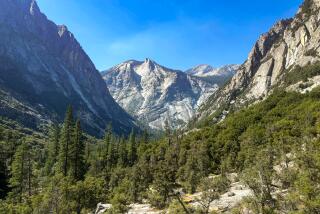Water Park Plan Faces Dry Future Amid Drought
- Share via
It would seem like a mirage on a hot summer’s day--a cascade of water slides, a lazy river for inner-tube floating, a wave machine churning up surf in a gigantic pool--all in the dusty-dry countryside along Interstate 15 north of Escondido.
But White Water Canyon water park may remain just a mirage.
In this sixth year of Southern California’s drought, the park’s promoters face some fearsome obstacles: neighbors, who almost to a person don’t want to live next to an amusement park; regulatory agencies that have woven a web of restrictions around the project; hard economic times that have made money almost as scarce as water and worst of all, Mother Nature. George Hice, spokesman for the group of small investors with a big idea, does not want details of his proposed water park, White Water Canyon Park, unveiled yet, but he has been forced to reveal some of the essentials to the county Department of Planning and Land Use.
According to the plans, the park would be a 16-acre oasis among the rock-studded hills that flank the inland freeway north of Escondido. In a natural bowl that was formerly a rock quarry, the theme park’s centerpiece, a giant surfing lake, will be created. Surrounding it on the rocky hillsides will be seven to nine water slides tailored to a sliding scale of adventurousness.
For lazier participants, White Water Canyon will offer a man-made river where inner-tube floaters can relax in slow motion. Picnic areas, a children’s pool, concession stands and a 1,384-space parking lot complete the proposal.
The water park would operate only in the warm months, from Memorial Day to Labor Day weekends during daylight hours, its backers say. It would attract 3,500 to 5,000 visitors daily, they estimated.
Still to be answered is where, in this arid country, during this long-running drought, the water park would get its water. For two years, Hice and other principals in the project have sought the answer.
More than two years ago, White Water Canyon backers had sought and obtained an agreement with the Vallecitos Water District to provide the 7.6 million gallons of water needed to float the theme park through a summer. As the drought worsened, the water company canceled its commitment, and the park promoters turned to wells.
Six wells have been drilled on the property at a cost of $100,000, attorney William Schwartz told the county Planning and Environmental Review Board recently in pleading for a time extension on the project’s major use permit application. The additional time would allow the owners to prove the wells’ capacity and complete an environmental impact report.
Schwartz obtained a time extension until April over department analysts’ recommendations that the major use application be denied, but the environmental review board members made it clear that they gave little chance to a water park being built in a drought.
Board Chairman Richard Empey politely suggested to the backers that they had “bad timing” in proposing a water park after six years of drought.
“I have a sneaking feeling this is one of those projects where a lot of expense and effort will be expended and may not be successful,” Empey said.
Richard Ringard, a rancher and neighbor to the property, took the White Water Canyon promoters to task for even considering drawing huge quantities of water from the underground aquifers “when avocado groves are dying and being cut back to conserve what water there is.”
Ringard also objected to bringing traffic into the pristine hillsides near his Windsong Lane groves, pointing out that Temecula-area students bound for colleges in San Marcos, Palomar College and Cal State San Marcos, already are causing traffic jams on the Deer Springs Road off-ramp from I-15 as they take a shortcut to classes.
Over the hill, in rural Twin Oaks Valley, some 200 people turned out two years ago to hear its backers promote the development of White Water Canyon. Not one rural resident sided with the investors.
Bill Seaton, a former Sea World executive and a former head of the California State Lottery, has some experience as well in water parks. He helped George Millay (one of Sea World’s creators) open a water park named Wet ‘N Wild in Las Vegas in the summer of l987.
Seaton sees some good and bad points in the White Water Canyon development.
A site in full view of freeway traffic is a lot better than a billboard in attracting crowds, Seaton said, and the topography sounds ideal. Drawing on his experience at Wet ‘N Wild, Seaton said some of the more spectacular slides can be a traffic hazard.
The Las Vegas park is on the Strip, within view of passing motorists. When wet bodies hurtled into space from a 7-story height, “quite a few rear-end collisions occurred” on the street below, Seaton said.
Seaton sees both pluses and minuses in the park’s rural location.
“On the good side, it could become ‘the in thing’ to surf in a wave machine-driven surf” and ignore nature-made curls 20 miles or so to the west.
But “how many people from San Diego are going to drive that far when there are so many other outdoor attractions--Mission Bay, the beach, the zoo--closer at hand,” Seaton asked.
Seaton also doubts that the water park would draw much attendance from outside the county because there are similar amusements in Orange, Riverside and Los Angeles counties.
The bottom line is “that I like the idea, but I don’t think I’d invest any money in it,” he said.
More to Read
Sign up for Essential California
The most important California stories and recommendations in your inbox every morning.
You may occasionally receive promotional content from the Los Angeles Times.










